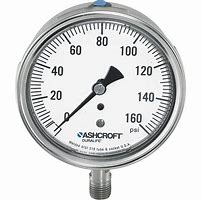
Pressure Gauges: A Comprehensive Guide to Choosing the Right One
In industries where precision and safety are paramount, pressure gauges serve as indispensable tools. Whether monitoring pressure, vacuum levels, or compound measurements, selecting the right gauge is crucial. A myriad of factors—connections, accuracy, and gauge types—play pivotal roles in this decision-making process.
Connections Matter:
The connection mechanism of a pressure gauge determines its compatibility with the system it monitors. Common types include:
-
Threaded Connections: These are versatile and come in various sizes, such as NPT (National Pipe Thread) or BSP (British Standard Pipe). NPT gauges are prevalent in North America, while BSP fittings are more common in Europe and Asia.
-
Flanged Connections: Suitable for high-pressure systems, flanged gauges provide a secure attachment via bolts and gaskets.
-
Tri-Clamp Connections: Predominantly used in industries like pharmaceuticals and food processing, these connections ensure airtight, sanitary conditions.
Accuracy Is Key:
The accuracy of a pressure gauge directly impacts the reliability of measurements. Precision varies among gauges, denoted as a percentage of full-scale output (%FSO). Factors affecting accuracy include:
-
Gauge Class: Ranges from 0.1% to 5% of the gauge's full scale. Critical applications demand higher accuracy gauges.
-
Temperature and Environmental Conditions: Extreme temperatures or harsh environments can influence accuracy. Specialized gauges with appropriate materials and designs mitigate these effects.
-
Regular Calibration: Ensures sustained accuracy over time. Periodic recalibration, ideally by certified professionals, is crucial.
Understanding Different Types of Gauges:
1. Pressure Gauges:
Pressure gauges measure pressure in systems, often using Bourdon tubes, diaphragms, or bellows mechanisms. They come in various types:
- Bourdon Tube Gauges: Common and versatile, these utilize a curved tube to measure pressure.
- Diaphragm Gauges: Suitable for low-pressure applications, they use flexible diaphragms to measure changes.
- Differential Pressure Gauges: Measure the difference in pressure between two points in a system.
2. Vacuum Gauges:
Monitoring negative pressure or vacuum levels, these gauges are crucial in industries like HVAC, laboratories, and manufacturing. Types include:
- Bourdon Tube Vacuum Gauges: Measure vacuum levels using the same principle as pressure gauges.
- Thermocouple Gauges: Ideal for measuring very low pressures by sensing thermal conductivity.
3. Compound Gauges:
Combining pressure and vacuum measurements in a single dial, compound gauges are useful for systems that alternate between positive and negative pressures. They feature two scales—one for positive pressure and one for vacuum.
Conclusion:
Selecting the appropriate pressure gauge involves a careful consideration of connections, accuracy requirements, and the specific type of gauge needed for the application. Each component plays a vital role in ensuring reliable and precise measurements within a given system.
Whether it's monitoring pressure in industrial machinery, gauging vacuum levels in a laboratory, or handling complex compound measurements, the right pressure gauge can make all the difference in maintaining operational efficiency, safety, and accuracy.
Compliance Note
The product statements contained in this guide are intended for general informational purposes only. Such product statements do not constitute a product recommendation or representation as to the appropriateness, accuracy, completeness, correctness or currentness of the information provided. Information provided in this guide does not replace the use by you of any manufacturer instructions, technical product manual, or other professional resource or adviser available to you. Always read, understand and follow all manufacturer instructions.
